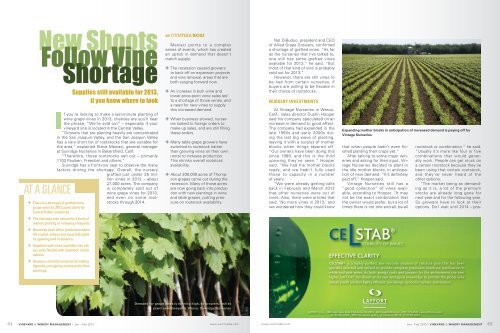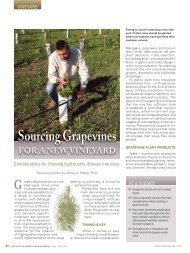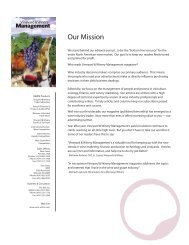New Shoots Follow Vine Shortage - Vineyard & Winery ...
New Shoots Follow Vine Shortage - Vineyard & Winery ...
New Shoots Follow Vine Shortage - Vineyard & Winery ...
You also want an ePaper? Increase the reach of your titles
YUMPU automatically turns print PDFs into web optimized ePapers that Google loves.
<strong>New</strong> <strong>Shoots</strong><br />
<strong>Follow</strong> <strong>Vine</strong><br />
<strong>Shortage</strong><br />
AT A GLANCE<br />
f you’re looking to make a last-minute planting of<br />
wine grape vines in 2013, chances are you’ll hear<br />
the phrase, “We’re sold out” – especially if your<br />
vineyard site is located in the Central Valley.<br />
“Growers that are planting heavily are concentrated<br />
in the San Joaquin Valley, and the San Joaquin Valley<br />
has a very short list of rootstocks that are suitable for<br />
the area,” explained Steve Maniaci, general manager<br />
at Sunridge Nurseries in Bakersfield, Calif.<br />
“Therefore, those rootstocks sell out – primarily<br />
1103 Paulsen, Freedom and others.”<br />
Sunridge has a front-row seat to observe the many<br />
factors driving the shortage. Overall, the nursery<br />
grafted just under 25 million<br />
vines in 2012 – about<br />
27,000 acres. The company<br />
is completely sold out of<br />
+ There is a shortage of grafted wine<br />
grape vines for 2013, particularly for<br />
Central Valley rootstocks.<br />
+ The shortage was caused by a burst of<br />
owners planting or renewing vineyards.<br />
+ Nurseries back off on production when<br />
the market softens, but must anticipate<br />
its upswing well in advance.<br />
+ Suppliers with vines available may ask<br />
you to be flexible with rootstock combinations.<br />
+ Growers can help nurseries by making<br />
deposits and signing contracts for their<br />
plantings.<br />
Supplies still available for 2013,<br />
if you know where to look<br />
wine grape vines for 2013,<br />
and even on some rootstocks<br />
through 2014.<br />
BY CYNTHIA ROSI<br />
Maniaci points to a complex<br />
series of events, which has created<br />
an uptick in demand that doesn’t<br />
match supply:<br />
+ The recession caused growers<br />
to back off on expansion projects<br />
and vine renewal, areas that are<br />
both surging forward now.<br />
+ An increase in bulk wine and<br />
lower-price-point wine sales led<br />
to a shortage of those wines, and<br />
a need for new vines to supply<br />
this increased demand.<br />
+ When business slowed, nurseries<br />
looked to foreign orders to<br />
make up sales, and are still filling<br />
these orders.<br />
+ Many table grape growers have<br />
switched to rootstock (rather<br />
than growing vines on their own<br />
roots) to increase production.<br />
This shrinks overall rootstock<br />
availability.<br />
+ About 200,000 acres of Thompson<br />
grapes came out during the<br />
recession. Many of those acres<br />
are now going back into production<br />
with new plantings in wine<br />
and table grapes, putting pressure<br />
on rootstock availability.<br />
Demand for grape vines is running high, as growers rush to<br />
plant new vineyards. Photo: Sunridge Nurseries<br />
Nat DiBuduo, president and CEO<br />
of Allied Grape Growers, confirmed<br />
a shortage of grafted vines. “As far<br />
as the nurseries that I’ve talked to,<br />
one still has some grafted vines<br />
available for 2013,” he said. “But<br />
most of that kind of vine is probably<br />
sold out for 2013.”<br />
However, there are still vines to<br />
be had from certain nurseries, if<br />
buyers are willing to be flexible in<br />
their choice of rootstocks.<br />
NURSERY INVESTMENTS<br />
At Vintage Nurseries in Wasco,<br />
Calif., sales director Dustin Hooper<br />
said his company speculated on an<br />
increase in demand to good effect.<br />
The company had expanded in the<br />
late 1990s and early 2000s during<br />
the last big wave of planting,<br />
leaving it with a surplus of mother<br />
blocks when things tapered off.<br />
“Our owners have been doing this<br />
since 1989, and this is the third<br />
upswing they’ve seen,” Hooper<br />
said. “We had the mother blocks<br />
ready, and we hadn’t fully used<br />
those to capacity in a number<br />
of years.<br />
“We were already getting calls<br />
back in February and March 2012<br />
that other nurseries were out of<br />
vines. Also, there were articles that<br />
said, ‘No more vines in 2013,’ and<br />
we wondered how they could know<br />
Expanding mother blocks in anticipation of increased demand is paying off for<br />
Vintage Nurseries.<br />
that when people hadn’t even finished<br />
planting their crops yet.”<br />
After talking to some major wineries<br />
and asking for their input, Vintage<br />
Nurseries decided to plant in<br />
the idle mother blocks, in anticipation<br />
of new demand. “It’s definitely<br />
paid off,” Hooper said.<br />
Vintage Nurseries still has a<br />
“good collection” of vines available,<br />
according to Hooper. “It may<br />
not be the exact combination that<br />
the owner would prefer, but a lot of<br />
times there is not one end-all, be-all<br />
STAB CELSTABILITY OF WINES<br />
®<br />
EFFECTIVE CLARITY<br />
rootstock or combination,” he said.<br />
“Usually it’s more like four or five<br />
combinations that would generally<br />
work. People can get stuck on<br />
a certain rootstock because they’ve<br />
been using that certain rootstock,<br />
and they’ve never heard of the<br />
other options.<br />
“The market being as demanding<br />
as it is, a lot of the premium<br />
stocks are already long gone for<br />
next year and for the following year.<br />
So growers have to look at their<br />
options. Do I wait until 2014 – pos-<br />
CELSTAB® is a highly-purified, low viscosity solution of cellulose gum that has been<br />
specially selected and refined to provide complete potassium bitartrate stabilization in<br />
white and rosé wines. As both energy costs and concern for the environment rise ever<br />
higher, LAFFORT has drawn on its vast enological knowledge to provide the global wine<br />
industry with another highly efficient, low energy option for tartaric stabilization.<br />
LAFFORT U.S.A. - 1460 Cader Lane, Suite C Petaluma, CA 94954 - laffortusa@laffort.com - (707) 775-4530 – www.laffortusa.com<br />
St HELENA STORE - 1309 Main Street, Suite C – St Helena CA 94574 - (707) 967-8290<br />
64 VINEYARD & WINERY MANAGEMENT | Jan - Feb 2013 www.vwmmedia.com www.vwmmedia.com Jan - Feb 2013 | VINEYARD & WINERY MANAGEMENT 65
sibly 2015 – or do I take something<br />
and get it in the ground and be in<br />
production by 2014 and 2015?”<br />
Duarte Nursery in Hughson,<br />
Calif., also has vines available,<br />
thanks to good planning. Owner<br />
John Duarte began planting the<br />
nursery’s new-generation rootstock<br />
block three years ago.<br />
“We have 175 to 200 acres coming<br />
into production, starting in 2011<br />
and 2012,” Duarte said. “We anticipated<br />
the demand, and we’re in a<br />
good position to supply the vines.<br />
We are also expanding our greenhouse<br />
facility in Hughson. We’ve<br />
gradually built capacity for another<br />
3 million vines, and this year we<br />
add capacity for another 9 million<br />
vines of production.”<br />
Duarte has built all the new<br />
greenhouses and outside bench<br />
areas in steel over cement, to<br />
ensure pathogen-free conditions.<br />
“Growers are very concerned<br />
about getting clean nursery stock,”<br />
he noted.<br />
IPM for Grapes:<br />
Your Pest Management Solution<br />
Davis’ Integrated Pest Management for<br />
Grapes software links your weather data to<br />
actual pest risk, helping you to prevent crop<br />
damage before it starts.<br />
Used together with our Vantage Pro2 Weather<br />
Station, a Wireless Leaf & Moisture/Temperature<br />
Station and Weatherlink ® software, Davis Instruments<br />
offers you a complete solution for crop management.<br />
For more information, please call 800-678-3669.<br />
(Left to right) John, Jim and Jeff Duarte of Duarte Nursery built new greenhouses to<br />
accommodate an additional 3 million vines.<br />
With a “good supply” left for<br />
2013 and 2014, Duarte is also offering<br />
3-foot-tall vines in larger pots<br />
for California’s North Coast, which<br />
VWM1301<br />
800-678-3669<br />
www.davisnet.com<br />
will bring vineyards into production<br />
faster. “Some of the super-highdensity<br />
pinot noir growers are using<br />
Buy Direct<br />
and Save!<br />
Your Source for All <strong>Vine</strong>yard Trellising Supplies<br />
Largest Manufacturer of<br />
Grape Stakes Nationwide!<br />
• Grape Stakes<br />
• Training Stakes<br />
• Anchors<br />
• Bird Netting<br />
• Crossarms<br />
• End Posts<br />
• Fencing<br />
• T-Posts<br />
• <strong>Vine</strong> Protection<br />
• Wire<br />
• Wood Stakes<br />
• Erosion Control<br />
• And More!<br />
800.423.8016 | www.JimsSupply.com<br />
those for their 2,500 to 4,000 vinesper-acre<br />
plantings,” Duarte said.<br />
EAST COAST IMMUNITY<br />
On the East Coast, the market<br />
remains largely immune to the supply<br />
vagaries experienced by California<br />
growers.<br />
“In the East, demand has been<br />
fairly consistent. Over the last several<br />
years, we never really peaked<br />
and we never really troughed,”<br />
said Dennis Rak, owner of Double<br />
A <strong>Vine</strong>yards nursery in Fredonia,<br />
N.Y. “We’ve been at steady-stage<br />
growth. For most Eastern varieties,<br />
things are going to be available as<br />
they have been in the past.”<br />
It also helps that Eastern wineries<br />
tend to be small operations.<br />
“A winery here might have 5,000<br />
cases, so even if they double their<br />
acreage – say by 20 acres – that’s<br />
not a huge issue,” Rak said. “The<br />
scale here is smaller. We are a<br />
younger industry, so what we really<br />
have got going on is just establishment<br />
and expansion of the existing<br />
industry on a pretty regular, predictable<br />
scale.”<br />
But for Eastern growers looking<br />
for vinifera varieties rather than<br />
hybrids or natives, sourcing vines<br />
may be a bit of a challenge. “For<br />
folks that call up at the last minute<br />
and say, ‘Hey, I need some chardonnay,’<br />
that might not be available<br />
this year,” Rak said.<br />
ORDER EARLY<br />
After weathering a soft market,<br />
nurseries want growers to confirm<br />
orders early with contracts and<br />
deposits.<br />
Vintage Nurseries takes orders<br />
three years in advance. “It’s never<br />
too early to order vines,” Hooper<br />
said. “If you order that far out, you<br />
can get exactly what you want –<br />
there’s no doubt about it.”<br />
Sunridge works to get firm<br />
orders. “Foreign buyers, who might<br />
also be loyal customers, are putting<br />
pressure on us,” Maniaci said, “so<br />
we’re trying to get our domestic<br />
growers to commit by signing a contract<br />
and giving us a deposit so we<br />
know their order for 2014 is real.”<br />
Steve Maniaci, general manager at Sunridge<br />
Nurseries, advises growers not to<br />
put off ordering vines.<br />
It’s important for growers to get<br />
out to the nurseries to see their<br />
facilities, Duarte added. “If growers<br />
are planting vines in the next<br />
couple of years, it’s important for<br />
them to get out and understand the<br />
resources that nurseries have, to<br />
see who can fulfill their needs.”<br />
GLOBAL DEMAND<br />
Although about 85% of Vintage<br />
Nurseries’ business stays in California,<br />
the company ships across<br />
the United States and into Canada,<br />
Mexico, Peru, South Africa and<br />
Australia.<br />
Sunridge also sells to overseas<br />
clients. It always takes care of its<br />
home base first, Maniaci said, but it<br />
also must honor foreign contracts.<br />
Selling abroad during a soft market<br />
at home helps keep nurseries in<br />
business.<br />
“Global demand is steady,” he<br />
said. “There are some countries<br />
that have been prospering in these<br />
times of recession. Brazil and China<br />
are two primary examples of a substantial<br />
increase in buying power on<br />
the average per-capita basis. Their<br />
overall movement toward drinking<br />
wine has caused much more<br />
demand for it.”<br />
As demand increases for Cali-<br />
fornia wines to export to countries<br />
such as China, the need for additional<br />
vineyard plantings will also rise.<br />
Thanks to forward-thinking nurseries<br />
upgrading their facilities to<br />
meet production requirements,<br />
vine shortages will be less likely to<br />
occur the next time there’s a planting<br />
boom.<br />
In the meantime, California<br />
growers’ best strategy is to visit<br />
nurseries to see what’s available,<br />
explore their rootstock options and<br />
order planting materials well in<br />
advance.<br />
Cynthia Rosi worked as a newspaper<br />
journalist in London for 10<br />
years before moving to Columbus,<br />
Ohio, with her vintner husband<br />
Paolo. He runs Via Vecchia <strong>Winery</strong>,<br />
and she writes articles and novels.<br />
Comments? Please e-mail us at<br />
feedback@vwmmedia.com.<br />
66 VINEYARD & WINERY MANAGEMENT | Jan - Feb 2013 www.vwmmedia.com www.vwmmedia.com Jan - Feb 2013 | VINEYARD & WINERY MANAGEMENT 67











